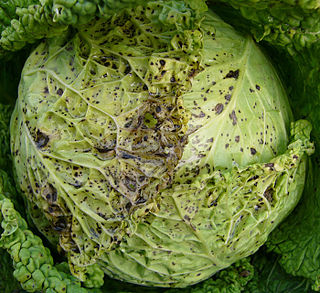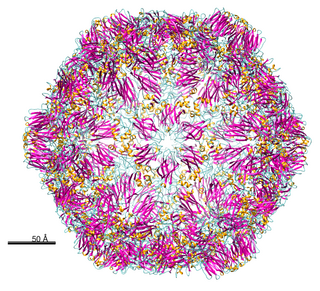
The Epstein–Barr virus (EBV), formally called Human gammaherpesvirus 4, is one of the nine known human herpesvirus types in the herpes family, and is one of the most common viruses in humans. EBV is a double-stranded DNA virus.

Bromoviridae is a family of viruses. Plants serve as natural hosts. There are currently 36 species in this family, divided among 6 genera.

Comovirinae is a subfamily of viruses in the order Picornavirales, in the family Secoviridae; its genera were formerly classified in the family Comoviridae. Plants serve as natural hosts. There are currently 62 species in this subfamily, divided among 3 genera.

Tymoviridae is a family of single-stranded positive sense RNA viruses in the order Tymovirales. Plants serve as natural hosts. There are currently 41 species in this family, divided among three genera, with two species unassigned to a genus.

Virus latency is the ability of a pathogenic virus to lie dormant (latent) within a cell, denoted as the lysogenic part of the viral life cycle. A latent viral infection is a type of persistent viral infection which is distinguished from a chronic viral infection. Latency is the phase in certain viruses' life cycles in which, after initial infection, proliferation of virus particles ceases. However, the viral genome is not eradicated. The virus can reactivate and begin producing large amounts of viral progeny without the host becoming reinfected by new outside virus, and stays within the host indefinitely.

Herpesviridae is a large family of DNA viruses that cause infections and certain diseases in animals, including humans. The members of this family are also known as herpesviruses. The family name is derived from the Greek word herpein 'to creep', referring to spreading cutaneous lesions, usually involving blisters, seen in flares of herpes simplex 1, herpes simplex 2 and herpes zoster (shingles). In 1971, the International Committee on the Taxonomy of Viruses (ICTV) established Herpesvirus as a genus with 23 viruses among four groups. As of 2020, 107 species are recognized, all but one of which are in one of the three subfamilies. Herpesviruses can cause both latent or lytic infections.

Potyvirus is a genus of viruses in the family Potyviridae. Plants serve as natural hosts. There are currently 183 species in this genus including the type species Potato virus Y. The genus is named after the type virus. Potyviruses account for ~30% of the currently known plant viruses. Like begomoviruses, members of this genus may cause significant losses in agricultural, pastoral, horticultural and ornamental crops. More than 200 species of aphids spread potyviruses and most are from the subfamily Aphidinae.
Tombusvirus is a genus of viruses, in the family Tombusviridae. Plants serve as natural hosts. There are currently 17 species in this genus including the type species Tomato bushy stunt virus. Symptoms associated with this genus include mosaic. The name of the genus comes from the type species: Tomato bushy stunt virus.
Equid alphaherpesvirus 1, formerly Equine herpesvirus 1 (EHV-1), is a virus of the family Herpesviridae that causes abortion, respiratory disease and occasionally neonatal mortality in horses. Initial spread of EHV-1 by a newly introduced horse through direct and indirect contact can lead to abortion and perinatal infection in up to 70 percent of a previously unexposed herd. Abortion usually occurs in the last four months of gestation, two to four weeks after infection of the mare. Perinatal infection can lead to pneumonia and death. Encephalitis can occur in affected animals, leading to ataxia, paralysis, and death. There is a vaccine available, however its efficacy is questionable. The virus varies in severity from sub-clinical to very severe. Most horses have been infected with EHV-1, but the virus can become latent and persist without ever causing signs of infection. In 2006, an outbreak of EHV-1 among stables in Florida resulted in the institution of quarantine measures. The outbreak was determined to have originated in horses imported from Europe via New York, before being shipped to Florida.

Gammaherpesvirinae is a subfamily of viruses in the order Herpesvirales and in the family Herpesviridae. Viruses in Gammaherpesvirinae are distinguished by reproducing at a more variable rate than other subfamilies of Herpesviridae. Mammals serve as natural hosts. There are currently 39 species in this subfamily, divided among 4 genera with three species unassigned to a genus. Diseases associated with this subfamily include: HHV-4: infectious mononucleosis. HHV-8: kaposi's sarcoma.

Nepovirus is a genus of viruses in the order Picornavirales, in the family Secoviridae, in the subfamily Comovirinae. Plants serve as natural hosts. There are currently 40 species in this genus including the type species Tobacco ringspot virus. Nepoviruses, unlike the other two genera in the subfamily Comovirinae, are transmitted by nematodes.

Carmovirus is a genus of viruses, in the family Tombusviridae. Plants serve as natural hosts. There are currently 19 species in this genus including the type species Carnation mottle virus. It is classified under the Baltimore classification system as a group IV virus, having a single-stranded, positive-sense RNA genome.

The mir-BHRF1-3 microRNA precursor found in Human herpesvirus 4. In Epstein-Barr virus, mir-BHRF1-3 is found in the 3' UTR of the BHRF1 gene, which is known to encode a distant Bcl-2 homolog. The mature sequence is excised from the 5' arm of the hairpin. Two other miRNA precursors were found in this reading frame, namely Mir-BHRF1-1 and Mir-BHRF1-2.
Carlavirus, formerly known as the "Carnation latent virus group", is a genus of viruses in the order Tymovirales, in the family Betaflexiviridae. Plants serve as natural hosts. There are currently 53 species in this genus including the type species Carnation latent virus. Diseases associated with this genus include: mosaic and ringspot symptoms.
Ringspot, a symptom of various plant viral infections, may refer to:

Secoviridae is a family of viruses in the order Picornavirales. Plants serve as natural hosts. There are currently 86 species in this family, divided among 8 genera or not assigned to a genus. The family was created in 2009 with the grouping of families Sequiviridae, now dissolved, and Comoviridae, now subfamily Comovirinae, along with the then unassigned genera Cheravirus, Sadwavirus, and Torradovirus.
Necrovirus is a genera of Tombusviridae. It is named after the type species, Tobacco necrosis virus A.
Amalgaviridae is a family of double-stranded RNA viruses. Member viruses infect plants and are transmitted vertically via seeds. The name derives from amalgam which refers to amalgaviruses possessing characteristics of both partitiviruses and totiviruses. There are ten species in the family.

Caulimovirus is a genus of viruses, in the family Caulimoviridae order Ortervirales. Plants serve as natural hosts. There are currently 13 species in this genus including the type species Cauliflower mosaic virus. Diseases associated with this genus include: vein-clearing or banding mosaic.
Macacine gammaherpesvirus 4 (McHV-4), commonly known as rhesus lymphocryptovirus (RLV), is a species of virus in the genus Lymphocryptovirus, subfamily Gammaherpesvirinae, family Herpesviridae, and order Herpesvirales.










